Executive Summary
The Grayce family caregiving survey was conducted in March 2021 among 1,000 Americans ages 18-65 with data collection provided by Ipsos. The survey sought to uncover the current state of family caregiving, the effects of the COVID-19 pandemic, and their impact on the employee experience.
Though there’s been significant discussion on the effects of COVID-19 on working mothers, this survey addresses the diversity of experiences among other caregiving employees. The survey identifies that the prevalence of family caregiving is common and diverse. Stress appears much earlier in the process and creates greater emotional complexity. Working caregivers and non-caregivers alike now have greater support expectations of employers.
Caregiving or not, these employees express greater affinity for companies that expand caregiving support, improving recruitment, retention, engagement, and well-being. Employers that seize this time to support working caregivers are those who are poised to be some of the most attractive employers in the years to come.
Key Findings
-
Nearly every member of the workforce in this survey (more than 3 in 4) has caregiving responsibilities outside of parenting and beyond supporting physical and medical care.
-
The vast majority of working caregivers are stressed (79%) and their stress starts far earlier than previously thought, when their loved ones are still independent.
-
The majority of stressors reported by working caregivers are relationship-oriented and emotional. Time intensity and confusion about what to do are the second and third most prevalent stressors, respectively.
-
The stress of balancing caregiving with work is so high that 55% of full time employees have left, adjusted their work or want to.
-
Nearly half of working caregivers (45%) are afraid to talk about it at work for fear of perceptions from others, showing HR has an active role in creating a safe space and normalizing the fundamental human experience of caring for loved ones.
-
Most employers aren’t supporting non-child caregiving employees.
-
Overwhelmingly, the majority of both caregivers and non-caregivers want better support from employers to help with caregiving, and they are far more engaged with employers who do.
Nearly Every Employee is a Caregiver
Despite typical outdated expectations on the profile of family caregivers, we found that more than 3 out of 4 employed respondents are caring for loved ones other than a child under the age of 18 (76%), and 82% are balancing full-time jobs. Beyond physical and medical care, these employees are providing emotional support, financial and legal guidance, and more.
What’s more, this survey found caregiving responsibilities are stressful and affect an employee’s ability to balance work and well-being. In fact, many caregivers are sacrificing career growth for caregiving responsibilities.
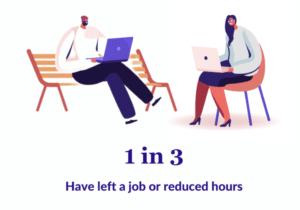

Majority of Stress is Rooted in Emotions & Relationships
The study found that 79% of these working caregivers feel stress, and that this stress starts far earlier than expected in the caregiving journey. Overwhelmingly, 74% of these working caregivers feel stress, even in the earliest stage of caring for loved ones who are still independent.
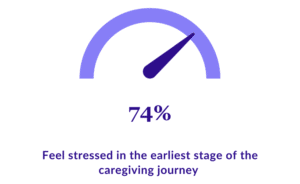
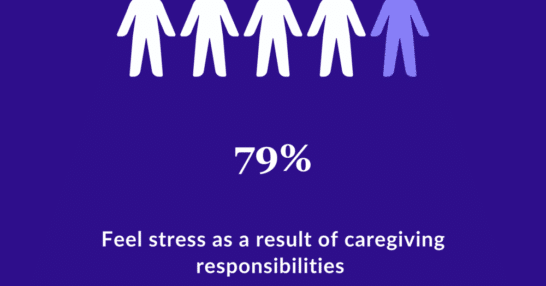
Emotional stress of the role is the most prevalent challenge reported by those caring for others (45%), also commonly coupled with challenges such as feeling supported, maintaining family boundaries, and navigating hard conversations and decisions. This emotional stress outranked time intensity (37%) and confusion about what to do (30%).
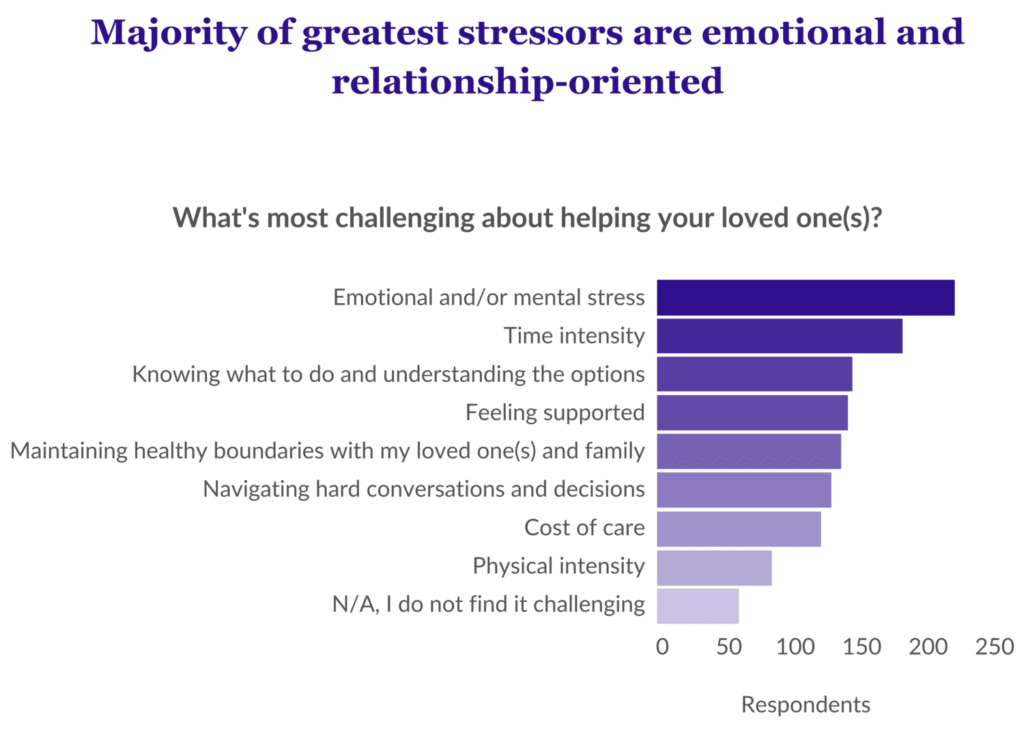
Pandemic Magnified a Caregiving Crisis
There’s no question that the COVID-19 pandemic put the strain of the workforce’s responsibilities at home and at work on full Zoom display. For more than half of workers in this survey (51%), the pandemic increased caregiving responsibilities. Organizations everywhere started seeing increased absenteeism, emailing at odd hours, signs of burnout, and exit interviews from valued employees of every generation, gender, ethnicity, location, and leadership level.
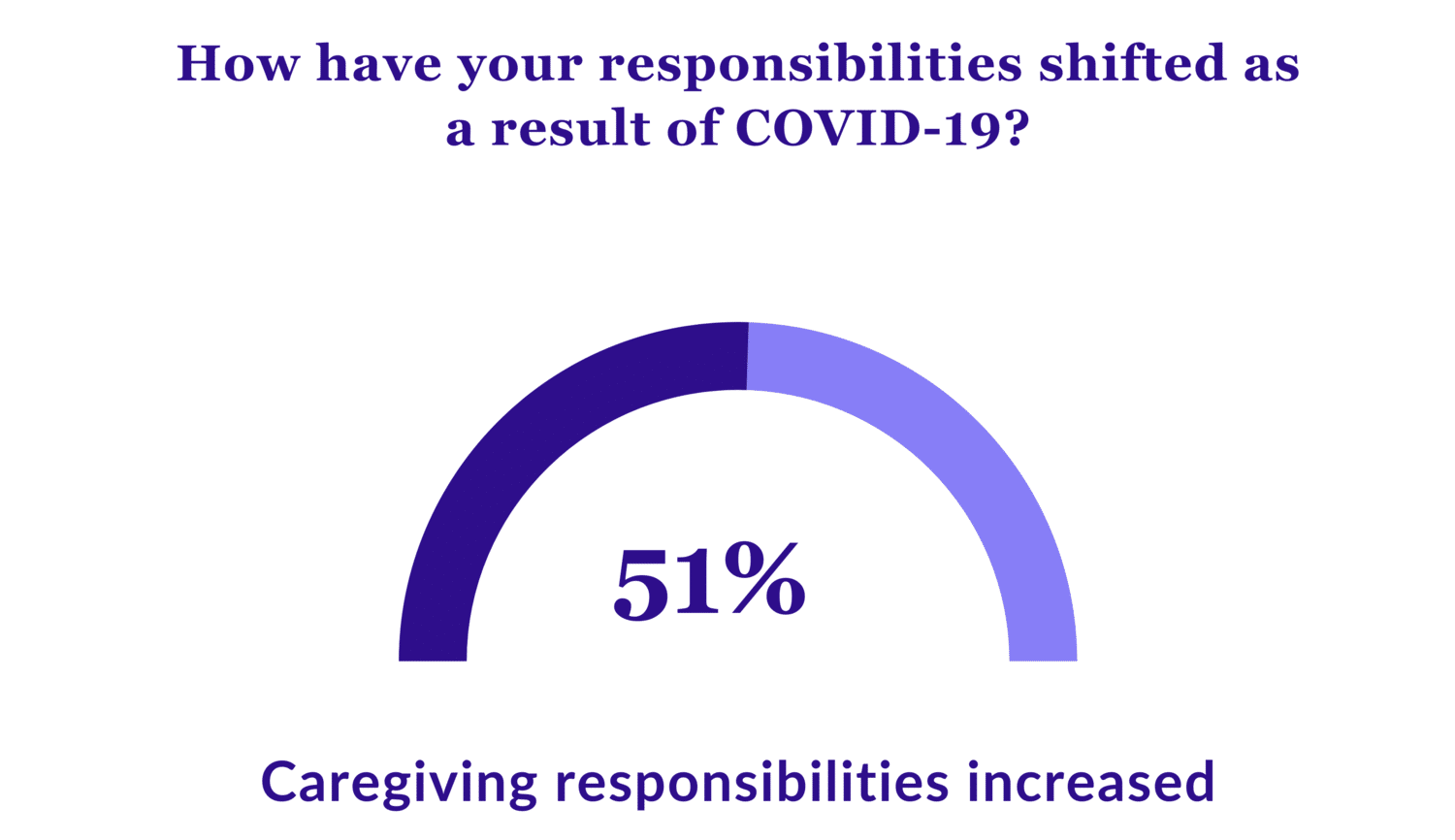
The COVID-19 pandemic illuminated a diverse, widespread, high-level risk of caregiver burnout threatening the workforce. The survey highlights the diversity of caregiving experiences and the tradeoffs experienced by multiple segments of the workforce.
The survey found that the stress of balancing caregiving with work is so high that 55% of these full time employees have adjusted their work or want to. Of full-time workers who adjusted work to help loved ones, 30% were from under-represented groups.
In the last year, over a quarter of full-time working caregivers left their jobs or reduced their hours to help their loved one(s) other than a child under the age of 18.
Millennials and Generation Z make up 71% of full-time working caregivers who left or are considering leaving their jobs in this study. Interestingly, despite no significant difference between genders for adult and elder caregiving, there are 1.4 times more male-identifying workers who reported extreme stress than female-identifying workers. What’s more, 1.4 times more male-identifying workers adjusted their jobs than female-identifying workers.
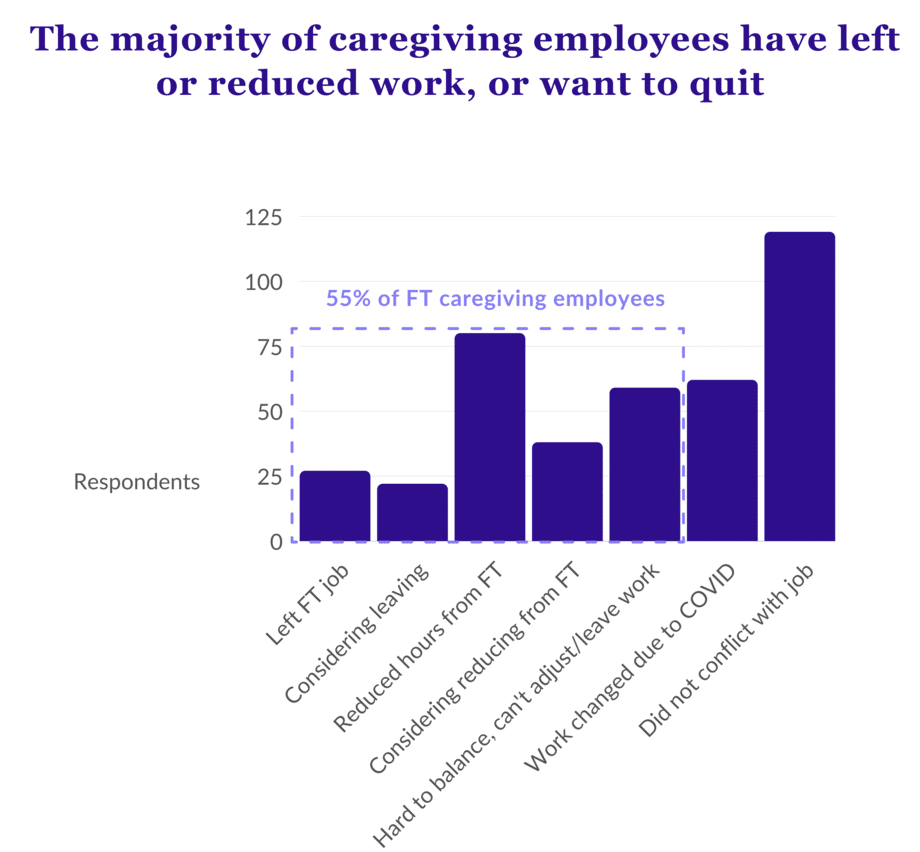
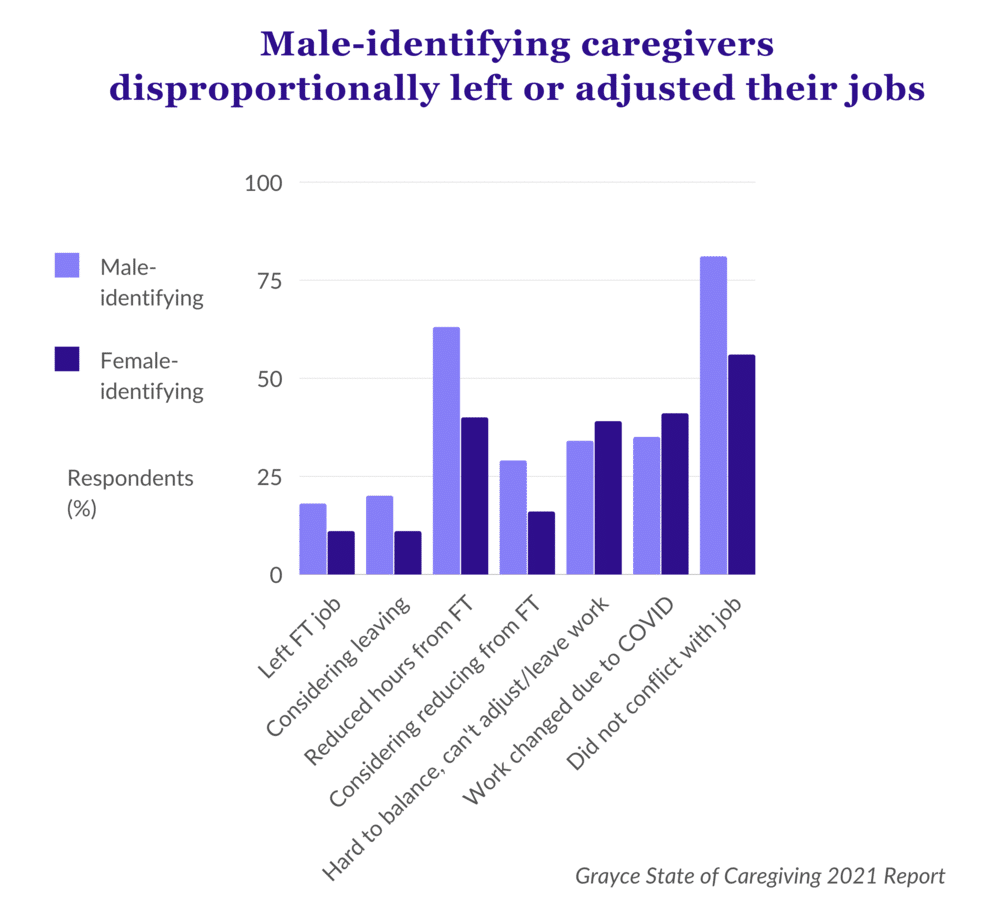
Though these findings about male and young employees may be surprising, it could be that we have overlooked the experiences of those who do not identify with the term “caregiver,” or that there are reasons they do not often share about their challenges. Their caregiving experiences raise further questions about the undisclosed challenges of multiple segments of the workforce.
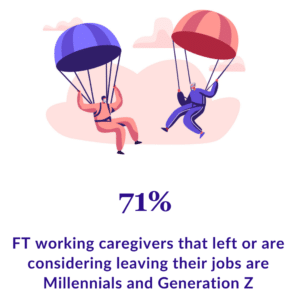
Fear Keeps Caregivers Quiet
Nearly half of these workers aren’t talking about their experience caring for their loved ones with their employers (45%). Why are employees holding back? The fear of perception from others at work.
For caregivers who haven’t told their employers about their additional responsibilities and stress in caring for loved ones, 1 in 5 cite the reason they haven’t is they don’t believe their employers care. Over 1 in 4 cite they don’t want others to think it affects their quality of work or that they are using it as an excuse.
For employers focusing on inclusion, Human Resources has an opportunity to play an active role in normalizing the fundamental human experience of caring for loved ones.


Employees Highly Value Employer Support for Caregiving
Overwhelmingly, both caregiving and non-caregiving employees in this study want employers to better support caregivers and are more engaged at work with employers that do.
The vast majority (4 in 5) of these employees believe employers should support caregiving at work. In fact, 82% agreed or strongly agreed that if their employer offered more caregiving support, they would feel the company cares about their well-being.
For these employees, supporting all caregivers directly affects well-being, stress, and feeling empowered to succeed.


When asked if their employer offered more elder caregiving support, 74% agreed or strongly agreed they would stay at the company longer, be more motivated to help the company succeed, and 64% say they find the company more attractive to work for.



For employers, supporting caregivers is a talent strategy. In the new era of work now, there is no question that caregiving support is a highly valued solution for all families that directly impacts recruitment, retention, engagement, and employee well-being.
Employers Must Evolve Approach to Succeed
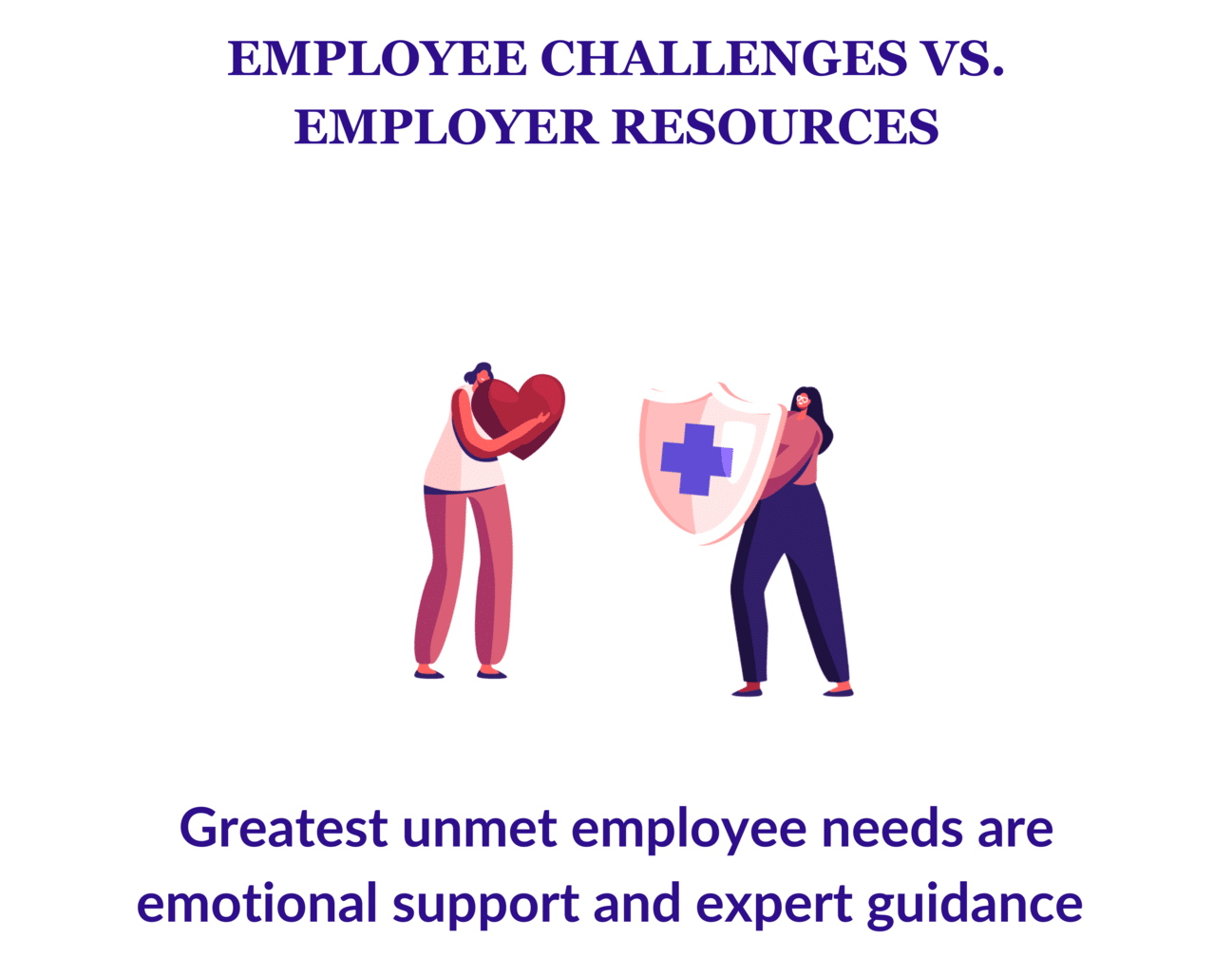 Most employers aren’t supporting non-child caregiving workers.
Most employers aren’t supporting non-child caregiving workers.
For those that do, while well intentioned, employees in this study report that their employers prioritize work flexibility 2.3x more than emotional support for caregivers, and 2.8x more than expert guidance – some of the primary stressors among caregivers.
Most employers do not offer inclusive caregiving support. Employers that shift focus toward an inclusive approach and directly address the most challenging employee needs will attract top talent and grow the business for years to come.
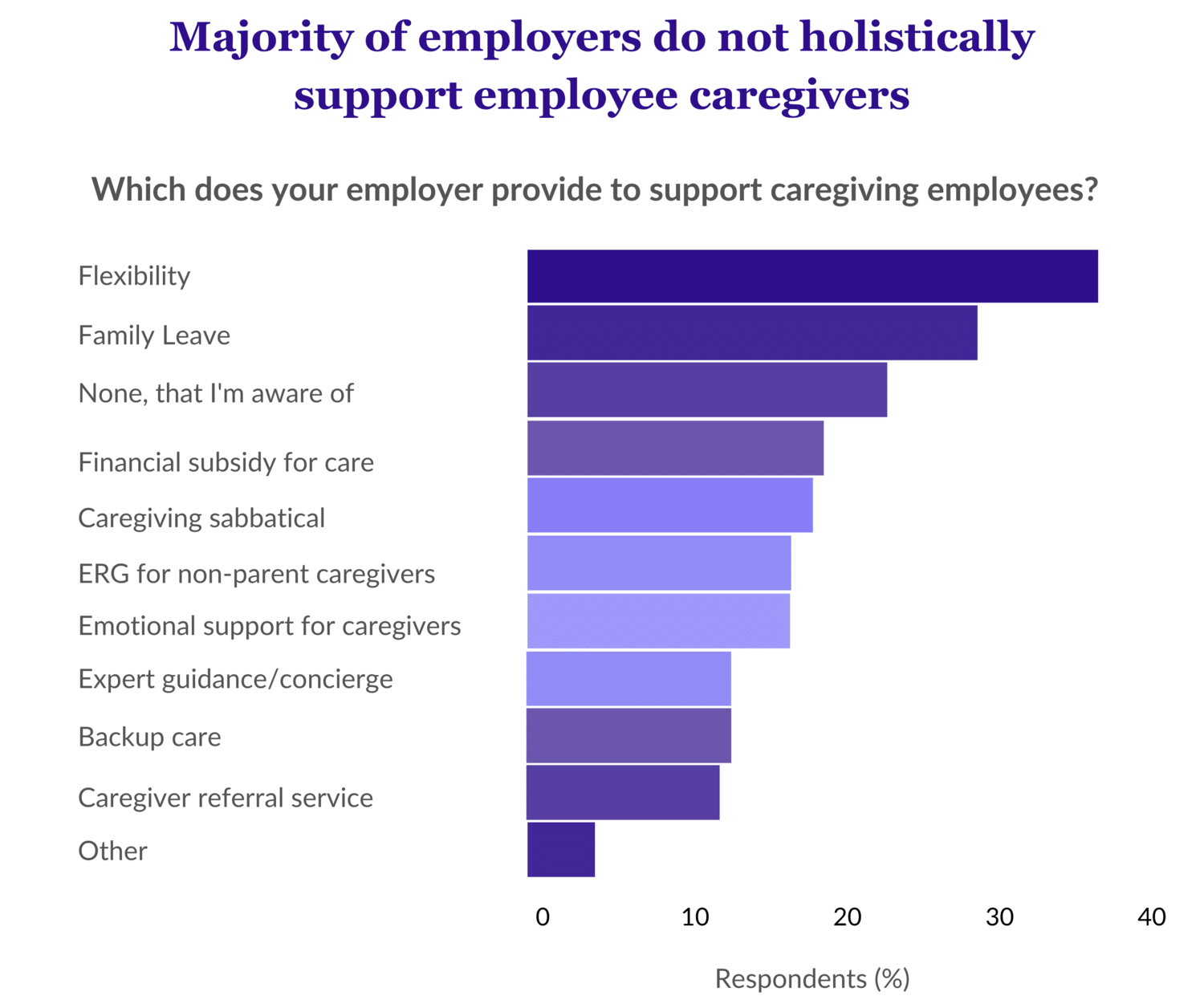
Building a Caring Culture
The pandemic has enlightened employers about the strain of balancing work and loved ones. From the recent emphasis on inclusion, caring cultures, and holistic health are indicators that Chief People Officers, HRBPs, and Heads of Total Benefits are paying attention to caregivers.
In this new era of work, demonstrating empathy is critical to retain, engage, and grow a high-functioning team. That’s why progressive organizations are re-evaluating their goals, asking “what are we actually trying to achieve?” then aligning programs and processes to empower their vision. At Grayce, we see this as an evolutionary process, which we call the ‘caregiving empathy ladder.’ In this whitepaper, we share a new perspective, rationale, and array of tactical approaches to create a caring organization that is inclusive for all employee families.
So how empathetic is your team culture compared to others?
About Grayce
Grayce is the only global caregiving empowerment solution enabling leading employers to support employees with family caregiving responsibilities, including 53 million in the United States alone. As the workforce faces epidemic rates of chronic illness and a rapidly growing, global aging population, we partner strategically with leading employers to build empathic cultures that attract and engage top talent with caregiving needs.
The Grayce caregiving solution provides employees a holistic, personalized care journey experience with 1:1 expert guidance, emotional, and logistical support. Employees empowered by Grayce are happier, healthier, and more engaged as they balance their roles at home and work. Founded in 2019, Grayce is headquartered in San Francisco.
Learn how Grayce can help support caregivers on your team.
Methodology
These are some of the findings of an Ipsos poll conducted between March 3-4, 2021 on behalf of Grayce Inc (more here). For this survey, a sample of 1,000 Americans age 18 to 65 from the continental U.S., Alaska and Hawaii were interviewed online in English. Quotas were set to align with the general population for age, gender and region. No weighting was employed. The precision of Ipsos online polls is measured using a credibility interval. In this case, the poll is accurate to within ± 3.5 percentage points, 19 times out of 20, had all Americans, age 18-65 been polled. The credibility interval will be wider among subsets of the population. All sample surveys and polls may be subject to other sources of error, including, but not limited to coverage error, and measurement error.

